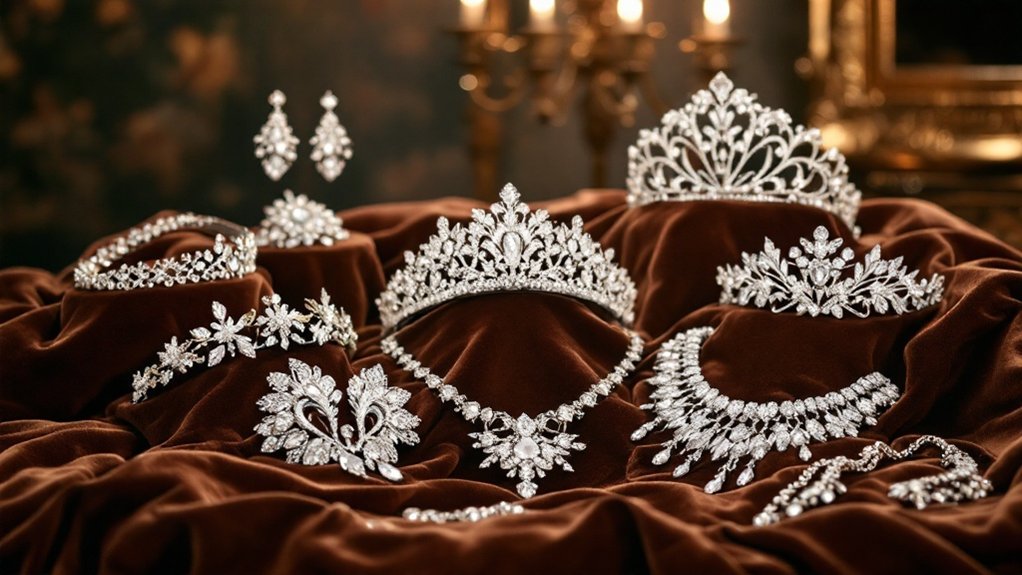Iconic Jewellery Designers of the 20th Century: Paul Flato: Hollywood’s Jeweller to the Stars
Paul Flato designed for the stars, adapted Hollywood glamour, and redefined American jewellery in the 20th century. Known for his fanciful yet sophisticated creations, Flato’s work adorned silver screen icons, turning his Sunset Boulevard boutique into a hotspot for the elite. His groundbreaking use of surreal elements and convertible styles set his pieces apart, hinting at a deeper artistry that went beyond mere ornamentation. Yet, behind the dazzle of diamonds lay a story marked by legal challenges and resilience.
What lies beneath the sparkle of Flato’s ambitious designs that continually captivates collectors and admirers alike?
Article Contents
Early Life and Career Beginnings
Although Paul Flato was born into wealth in 1900 in Shiner, Texas, his true calling emerged from unexpected places. His family heritage was steeped in the riches of Texan cattle, with his German great-grandparents laying the town’s foundations.
Despite an upbringing amidst opulence, it was the gypsies selling silverware that captured his youthful imagination. Cultural influences from his German descent and early exposure to high society fuelled an appreciation for elegance, which eventually shaped his passion for jewellery design.
Flato’s academic path began at the University of Texas, where he flirted briefly with medicine before veering toward New York’s vibrant scene. This shift was partly due to his family’s decision to withdraw financial support, nudging him towards independence. Captivated by the world of adornment, he eventually developed a profound interest in unique jewellery creations. His remarkable journey in jewellery design began when he moved to New York City in 1920 to pursue business studies at Columbia University.
He attended Columbia University, gaining broader cultural insights and refining his artistic tastes. The allure of the jewellery world became irresistible, leading him to a position at Edmund Frisch, a prestigious jewellery and watch dealer.
Rise in Hollywood
In 1937, Paul Flato established himself at the heart of Hollywood’s glamour by opening a boutique on Sunset Boulevard, adeptly positioning himself across from the iconic Trocadero nightclub. His fanciful and flamboyant designs, often showcased on the likes of Greta Garbo and Katharine Hepburn, quickly made him the favoured jeweller among silver screen legends. With his keen understanding of opulent themes and craftsmanship, Paul Flato’s creations exuded a sense of casual opulence that resonated with Hollywood’s elite.
Demonstrating his influence, Flato’s masterpieces not only adorned Hollywood’s elite off-screen but also gleamed in film credits alongside his own on-screen appearances. Flato opened his first jewellery shop on One East 57th Street in Manhattan, where his reputation as a leading jeweller began to form, drawing comparisons to prestigious European jewellers.
Hollywood Celebrity Clients
Paul Flato’s rise in Hollywood celebrity circles was marked by his knack for capturing the essence of glamour through his exquisite jewellery designs. His second shop, strategically located on Sunset Boulevard in Beverly Hills, became a magnet for the elite. Hollywood stars, drawn by his unique flair and the promise of individuality, quickly embraced Flato’s creations.
Flato was the first jeweller to have his name in the credits of a film, which further solidified his ties with the film industry. Celebrity endorsements played a pivotal role in cementing his reputation. On and off screen, icons like Greta Garbo and Rita Hayworth adorned Flato’s jewellery, dazzling audiences and critics alike. His designs graced the red carpet appearances of Hollywood’s Golden Era legends, such as Katharine Hepburn, who famously wore Flato’s pieces in the film Holiday, enhancing their allure with his groundbreaking style.
Flato’s fanciful touch and inventive use of platinum and diamonds captured the imagination of discerning clients like Marlene Dietrich, who commissioned a striking diamond and cabochon emerald bangle. Mae West even inspired a distinctive diamond “corset” bracelet, a testament to Flato’s ability to translate personality into art. In a world that cherished exclusivity and creativity, Flato’s jewellery provided an expressive escape, offering clients a piece of the Hollywood glamour they so fervently desired.
His legacy was instrumental in raising American jewellery design standards to compete with European excellence, leaving a lasting influence on future generations.
Iconic Film Collaborations
Hollywood’s acceptance of Paul Flato’s artistry was most evident in his iconic film collaborations. His visionary approach manifested in key films like Holiday (1938), where his jewellery took the spotlight alongside Katharine Hepburn’s classic attire. Notably, the jewellery featured in the film was highlighted in multiple Women’s Wear Daily articles during 1938, which showcased Flato’s classic designs. Here, Flato’s three-strand diamond necklace and fanciful black enamel hand with a diamond cuff harmonised effortlessly with Robert Kalloch’s classic costume lines, embodying true Film Integration. His influence and bespoke designs were integral, not supplementary, to these cinematic masterpieces.
Flato’s role extended beyond design; he showcased his talents with an on-screen cameo as a jeweller in Hired Wife (1940), cementing his dual charisma in both craftsmanship and silver screen presence.
In That Uncertain Feeling (1941) and Blood and Sand (1941), his creations adorned stars Merle Oberon and Rita Hayworth, respectively, illustrating his commanding niche in Hollywood.
Renowned for his Art Deco style, Flato’s jewellery drew from eclectic themes and fanciful inspirations, revealing a unique narrative within each piece. His collaboration with directors and designers transformed Hollywood’s visual lexicon, as Flato’s elegance didn’t just embellish costumes but defined them.
Celebrated in publications like Women’s Wear Daily, his name became synonymous with glamour and innovation in film.
Sunset Boulevard Boutique
Set against the glamorous backdrop of Sunset Boulevard, Flato’s boutique quickly became a cornerstone of Hollywood’s high society. Opened in 1938 and situated across from the renowned Trocadero nightclub, the boutique’s ambience attracted the elite of Hollywood.
Its strategic location not only cemented Flato’s relationships with celebrity clientele but also showcased his ingenious designs influenced by the Surrealist movement.
Within this iconic boutique, visitors found an array of sculptural, fanciful jewels. Surrealist inspirations brought unexpected themes to life—jewels fashioned as feet, nuts and bolts, and playful cacti. Notable series included the gold sign language brooches and an intriguing “gold digger” bracelet complete with a gold pickaxe. Visitors were also captivated by the stunning Cartier trilogy ring, featuring three exquisite diamonds set in platinum. The craftsmanship and attention to detail in each piece were truly remarkable, leaving guests in awe of the artistry on display. The boutique’s collection of artisanal jewelry was a testament to the creativity and imagination of the designers, offering visitors a unique and unforgettable shopping experience.
Flato was ahead of his time, embracing the 1940s trend of convertible jewellery, offering pieces that could transform to suit any occasion.
The boutique’s clientele read like a who’s who of film legends—Greta Garbo, Rita Hayworth, Marlene Dietrich. Flato’s jewels adorned these stars on and off-screen, earning credits in diverse productions.
Employing designers like George Headley and Fulco di Verdura, Flato’s boutique continued to craft theatrical, timeless pieces that solidified his legacy as “Jeweller to the Stars.”
Distinctive Design Elements
A hallmark of Paul Flato’s distinctive design elements lies in his ability to blend whimsy with elegance, using unexpected subjects and bold motifs. Naturalistic motifs, like his signature “drippy” floral designs featuring sculptural leaves and petals adorned with diamonds, exude both beauty and playfulness. His rise as a prominent jeweller coincided with the location of his salons in New York, Los Angeles, and Mexico City, allowing him to cater to society’s elite clientele seeking his artistic creations.
He embraced fanciful designs, crafting pieces with unconventional subjects like feet, cacti, and even sign language hands, inviting a spirit of adventure to adorn oneself with jewellery that tells a story. Paul Flato opened his own shop in New York City, where he attracted an elite clientele seeking his imaginative designs.
Flato’s pioneering approach extended to his choice of materials. He often incorporated rare coloured stones like the Jonker diamond, along with significant sapphires and rubies, turning these exceptional elements into dramatic, oversized creations that remain graceful.
His use of platinum and gold further showcased his talent in distinguishing between formal and expressive pieces.
Travelling influenced Flato greatly, as his travels to Europe and the Americas brought a tapestry of cultural elements into his work. This global inspiration led to unique, personal touches in his jewellery, with personalised elements like initials and nicknames often featuring.
Flato’s pursuit of unusual colour combinations, such as aquamarine and ruby, set his work apart and cemented his legacy as a trailblazer in jewellery design.
Legal Troubles and Challenges
Amidst his flourishing career, Paul Flato faced significant legal troubles that dramatically altered his trajectory. The famed jeweller to the stars fell into a web of financial missteps, leading to a harsh legal fallout. In the late 1930s, he created a line of brooches called Deaf and Dumb due to his hearing loss, showcasing his continued design innovation despite personal challenges.
Convicted of grand larceny in 1943, he was sentenced to 18 months at the infamous Sing Sing prison. His downfall stemmed from pawning gems consigned to him, a desperate attempt to raise cash, which ultimately revealed a series of unauthorised sales. The loss of a 17-carat emerald-cut diamond marked Flato’s irreversible plunge into illegal activities. Despite these setbacks, Flato’s legal battles continued unabated as he navigated numerous court cases following his conviction, which only added to his growing legal challenges.
Flato’s conviction shattered his business, leaving him financially and reputationally broken. His arrest and imprisonment disrupted his once-promising career, forcing him to rebuild from the ground up more than once.
The legal fallout was severe, as he faced further financial struggles, leading to yet another stint behind bars. The compulsion to flee to Mexico in an attempt to evade extradition only prolonged his challenges.
Even then, freedom was elusive, as he served a four-year term in Lecumberri prison, later returning to the UK to fulfil another five-year sentence. These legal tribulations, though profound, didn’t extinguish his creative spirit entirely.
Later Years and Ventures
Following a period marred by legal troubles, Paul Flato undertook a remarkable path of redemption, returning to the world of jewellery with renewed vigour. Establishing a shop in Mexico City in 1970, Flato infused his designs with vibrant nods to indigenous culture, resulting in dazzling masterpieces that captivated a new generation of jewellery aficionados.
Despite his setbacks, Flato continued designing jewellery in Mexico City, demonstrating his enduring passion for creativity and craftsmanship. His work during Hollywood’s Golden Era included designing jewellery for six films, which reinforced his reputation as a jeweller celebrated by the stars. His legacy, enduring in both style and influence, is celebrated not just through his iconic jewels but also in the pages of books and the halls of prestigious auction houses, affirming his status as a luminary in 20th-century American jewellery design.
Legal Troubles and Consequences
Paul Flato’s life took a dramatic turn in 1943 when he was convicted of fraudulently pawning $100,000 in jewels that belonged to clients. His prison experience at Sing Sing Penitentiary, where he served 16 months, deeply impacted public perception of the once-celebrated Hollywood jeweller.
Known as Hollywood’s Jeweller to the Stars, high-profile clients adored Flato’s extravagant lifestyle and distinctive pieces, but his legal woes cast a long shadow over his career. Despite maintaining his innocence—claiming the jewels were pilfered by a tailor from a garment pocket—the legal troubles tarnished his reputation. His release in 1945 didn’t alleviate his woes, as he soon faced supplementary charges of larceny and forgery related to a fortune teller. Some speculate his financial constraints and burgeoning debts, stemming from lavish spending, contributed to his downfall.
The consequences of these legal challenges were profound. Flato’s illustrious Hollywood career came to an abrupt end post-1943, and he never regained the favour of Tinseltown’s elite. Although he continued his craft, he did so under a veil of relative anonymity, far from the limelight he once revelled in.
His later ventures included designing pens and compacts, hinting at creative resilience. In 1970, he opened a jewellery store in Mexico City, tending to it until 1990, hinting at a yearning to create anew, away from past shadows that dimmed his former brilliance.
Return to Jewellery Craft
In the later years of his career, Paul Flato experienced a creative resurgence with the opening of his jewellery shop in Mexico City in 1970. Marking a distinct post-prison revival, this venture allowed Flato to channel his artistic vision through a vibrant Mexican lens. The Zona Rosa boutique became a style hub, exuding the flamboyance for which Flato was celebrated. His designs during this period drew heavily from Mexican inspiration, blending indigenous motifs with dazzling colour combinations.
Cacti, radishes, and other unexpected subjects graced his pieces, reinforcing Flato’s fanciful aesthetic. Not unlike Theodore B. Starr, who gained fame for using diverse gemstones, Flato’s jewellery was also characterised by using varied and colourful stones. Operating for two decades, the Mexico City shop attracted an affluent clientele, emphasising Flato’s flair for catering to the elite.
Recognised as a leading jeweller in New York in the early twenties, Flato built on his capabilities to maintain his appeal in Mexico. With his reputation extending beyond Hollywood’s stars to discerning Mexican patrons, he maintained relevance in a rapidly evolving industry. Skilled designers collaborated with him, ensuring that his signature style evolved while retaining its spirited essence.
Flato’s later years weren’t just about business; they embodied a return to the roots of jewellery craftsmanship, as he meticulously crafted each piece. In 1990, at 90 years old, Flato returned to Texas, his experiences and stories weaving an enchanting tapestry of his life.
Legacy and Redemption
Decades after his Hollywood heyday, Paul Flato embarked on a remarkable path of legacy and redemption. Following a tumultuous period marked by legal setbacks, his redemption odyssey began as he turned to groundbreaking ventures.
After his release from prison, he changed his focus, creating imaginative, compact designs that highlighted his uniqueness and contributed to his financial stability. This venture signalled a departure from Hollywood’s glittering allure and demonstrated his resilience and adaptability.
A pivotal chapter unfolded in 1970 when Flato initiated a new adventure, opening a shop in Mexico City’s Zona Rosa. Embracing the vibrant culture, he designed exquisite jewellery, drawing inspiration from indigenous art and folk symbolism.
These creations, rich in colour and cultural homage, garnered immense success, solidifying his legacy impact in contemporary jewellery design.
As Flato retired to Texas in 1990, he basked in the warmth of family and friends, recounting stories of past glory and craftsmanship. His life’s work remains a tribute to enduring elegance, with his jewellery pieces revered as highly collectible valuables.
Paul Flato, once Hollywood’s jeweller to the stars, proved that one’s legacy can transcend challenges, leaving an indelible mark on the world.
Enduring Influence and Legacy
Throughout the decades, Paul Flato’s influence on American jewellery design has remained substantial due to his pioneering spirit and groundbreaking techniques. A true innovator, Flato seamlessly blended design innovation with cultural impact, creating timeless pieces that echo his brilliant artistry.
His bold incorporation of Surrealist imagery shattered traditional norms, transforming everyday objects like bolts into unexpectedly luxurious accessories. This approach resonated with an audience yearning for self-expression, breaking free from the constraints of conventional design.
Flato’s enduring legacy lies in his role as a trailblazer of a distinctive American jewellery style. Employing renowned designers such as George W. Headley and Count Fulco di Verdura, he cultivated a collective of creative minds who pushed the boundaries of jewellery artistry.
His work considerably influenced future generations, leaving an indelible mark on the fashion landscape.
Despite the passage of time, Flato’s pieces continue to captivate collectors and enthusiasts alike, frequently commanding substantial sums at auctions. His Art Deco oeuvre, marked by wit and flamboyance, remains a source of inspiration for contemporary designers, reinforcing its historical significance and continual relevance in modern fashion.
Flato’s contributions to the jewellery industry embody enduring creativity and innovation.
Celebrated Exhibitions and Recognition
While Paul Flato’s pioneering designs have captivated audiences for decades, his celebrated exhibitions and recognition in both galleries and publications further confirm his monumental impact on the jewellery world.
His artistry has seen the inside of museum features like “Masterpieces of American Jewellery” at the American Folk Art Museum, which displayed seven of his exquisite pieces. Theatrical elegance comes alive with Flato’s gems at Phillips’ New York auction, transcending time and tradition, becoming auction highlights.
His participation in “Hollywood Jewels: Movies, Jewellery, Stars” solidified his allure, intertwining cinema’s glamour with ornate craftsmanship.
Beyond exhibitions, Flato’s legacy thrives in influential publications such as “Paul Flato: Jeweller to The Stars” by Elizabeth Irvine Bray and “American Jewellery: Glamour & Tradition.” His storied connections with Hollywood are immortalised in magazine pages of Vogue and Harper’s Bazaar.
Even the silver screen paid tribute to his allure with an appearance in the 1940 film “Hired Wife.” His multifaceted designs, from cinematic adornments to fanciful compacts, illustrate a vivid career celebrated globally.




